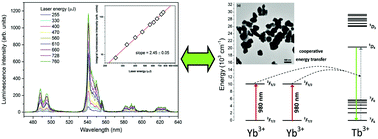Synthesis and spectroscopic properties of Yb3+ and Tb3+ co-doped GdBO3 materials showing down- and up-conversion luminescence
Abstract
Gadolinium orthoborates doped with Yb3+ and Tb3+ ions were synthesised by the sol–gel Pechini method. Materials annealed at 900 °C were composed of the monoclinic GdBO3 phase with micrometre-sized crystals. The structural properties of the products were analysed by X-ray diffraction (XRD) and transmission electron microscopy (TEM). The composition of the prepared materials was determined by inductively coupled plasma optical emission spectroscopy (ICP-OES). The materials showed intense ultraviolet (UV) or near infrared (NIR) excited green emission, which resulted from down- or up-conversion processes taking place in their structure. Spectroscopic properties were investigated on the basis of the measured excitation and emission spectra. Also, luminescence decays showing a short rise of emission with time after NIR excitation were measured. The dependence of the integral up-conversion intensity on the energy of the pumping laser was measured. The results indicated a two-photon process based on cooperative energy transfer (CET). The analysis of the synthesised series of samples allowed us to identify those with the best emission under a UV or NIR excitation source.


 Please wait while we load your content...
Please wait while we load your content...